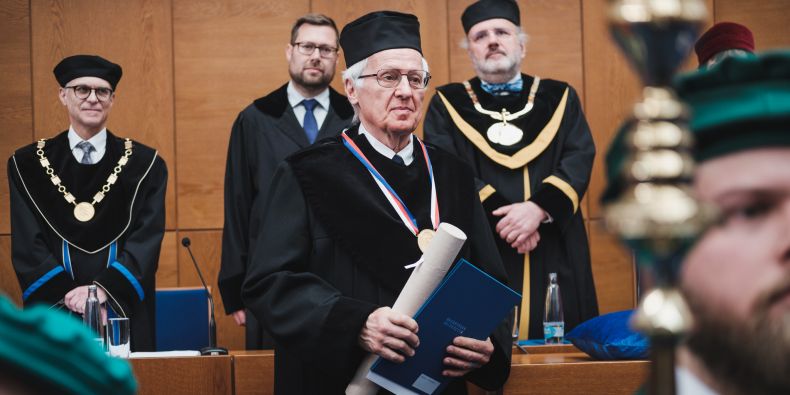Ondřej Křivánek is a world-renowned physicist, instrument designer and technology developer who has made such important breakthroughs in electron microscopy and its instruments that he is known abroad as a microscopy wizard. In April he received an honorary doctorate from Masaryk University.
Born in Prague, he graduated from the University of Leeds and received his PhD in electron microscopy from the University of Cambridge. He currently lives in the United States where he is the president of Nion, an American electron microscope manufacturer. In 2020, he was awarded the prestigious Kavli Prize in Nanoscience.
What do you see as the remaining challenges in the field of electron microscopy?
Instrumentation for electron microscopy has made great leaps in the past 30 years. However, this progress has revealed a new limitation of spatial resolution: the vibrations of atoms in solids that blur their image. This leads to a resolution limit of 30-70 pm that no electron microscope can overcome, no matter how perfect its optics become. The best scanning transmission electron microscopes (STEM) have already reached this limit, so no fundamental improvement in spatial resolution can be expected.
So where does the field go from here?
There are other important challenges, such as improving the temporal resolution of electron microscopy and the energy resolution in spectroscopy. The physical limits in these fields are still far off, and in the area of energy loss spectroscopy, we are now trying to improve the resolution to about 1 meV. Another important direction involves the development of new kinds of microscope-mounted micro-laboratories that will make it possible to observe samples under various conditions corresponding to those in which the materials are used outside the microscope: in hot or cold environments, in corrosive atmospheres, in water, and so on. We want to get as much information as possible about the sample before it is “burned” by the electron beam, which is very energetic and often damages the sample. I also see the potential for improvement in automating the operation of the microscopes and in interpreting the results using specialised software that will increase performance while making the microscopes more accessible even to less experienced users.
Can Brno and the research being carried out here make a difference in this area?
Brno is currently a world leader in scanning electron microscopy (SEM), for example in the design of ultra-compact electron microscopes, environmental SEM (for samples in a gaseous environment), ultra-low-voltage SEM and focused ion beam in-situ milling. Current challenges include building on the progress achieved in these areas, as well as basic research in transmission electron microscopy (TEM/STEM), which offers higher spatial resolution and more powerful analytical methods.
What was the biggest surprise in your research career?
I like to say that progress in science is similar to hiking in the mountains. You start low in a densely forested valley and cannot see very far, but you know that the view will get better the higher you go. As you climb, you can suddenly see much further. Some views are unexpected and can surprise you with how beautiful they are. I have personally experienced several such views, such as when we realised how much better we could resolve atoms with the aberration-corrected electron microscope we had been working on for so many years, or when we saw our first vibrational spectra, which opened up a new world of experimental possibilities. Most surprising to me, however, was how well my colleagues and I succeeded in meeting the scientific challenges that intrigued me early in my career – improving the spatial and energy resolution of electron microscopy. And how long and twisty the road to that was.
You are someone who doesn’t like to give things a rest and is constantly looking for better solutions. Do you look for those in your professional life only, or do you do this in your private life as well?
Science moves forward best when you can clearly see what milestones you have reached in your research and make the right decisions about what you should try to achieve next. It is important to recognise dead ends and avoid them, but also to be resourceful and not get too tied up by conventions when you are charting your path. Since science is logical and predictable and not subject to human whims, this approach works rather well. Adapting it to your personal life is possible, but you can hardly guarantee positive results.
You like nature, travelling and photography. Do you wish you had more time to pursue these interests? What are your plans for the near future?
The two things I have always enjoyed are science and travel. As a university student in England, I spent 30 weeks a year studying and another 22 weeks travelling. This seemed like a good balance to me, but as I progressed in my career, the time for travel diminished. Only now, when I am at an age when people usually want to retire, I am able to strike a better balance between work and travel. I am currently on a six-month sabbatical in Berlin, which has been productive scientifically and also allows me to explore a new, very interesting and pleasant city. My wife and I are planning a three-week road trip through Scandinavia in June, and in July we will go on a cruise from Anacortes in Washington state to Canada, on an 8-person sailboat, with me as captain. And then I’ll be doing further research in Nion, where we’re working on a lot of very interesting projects.
